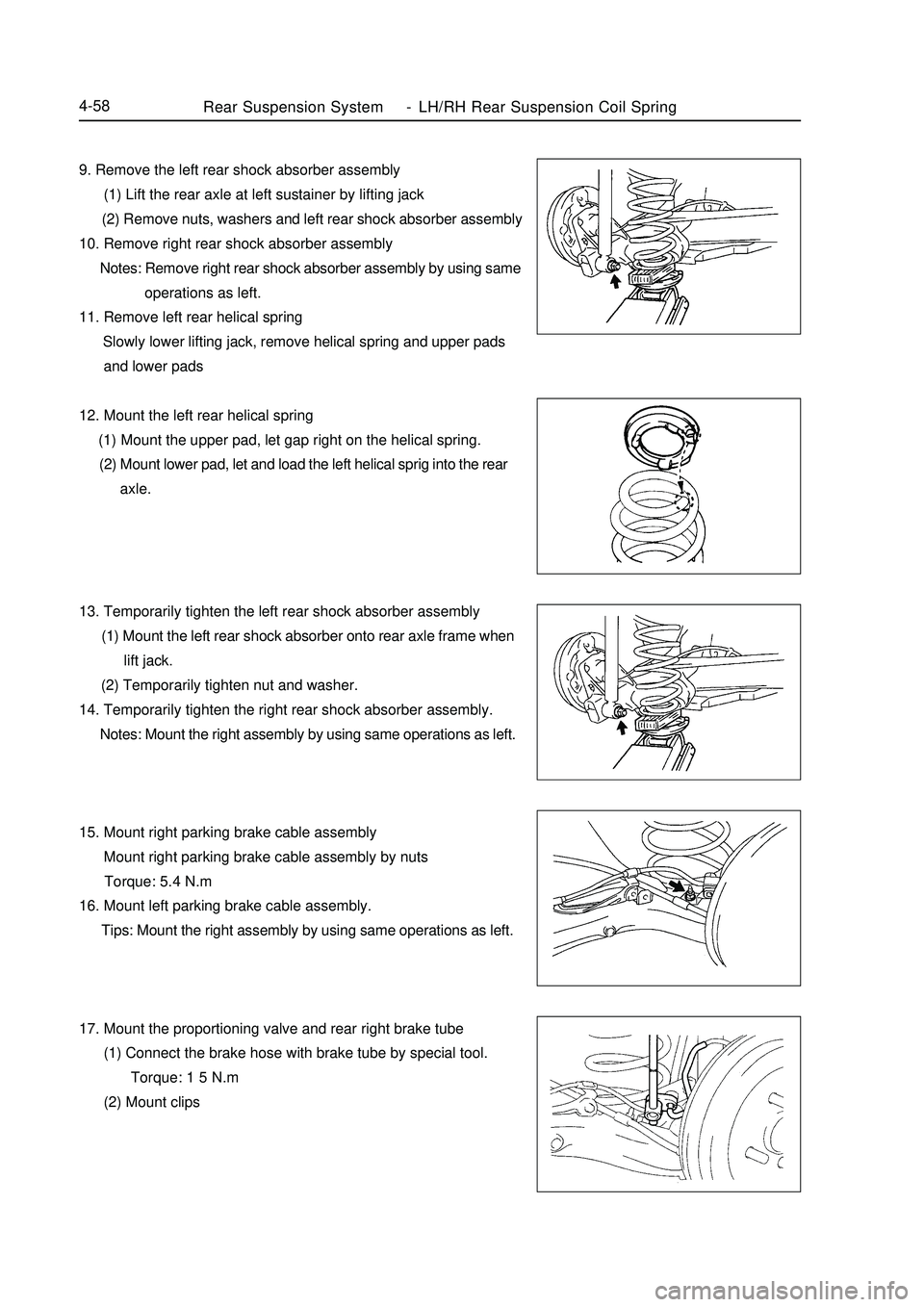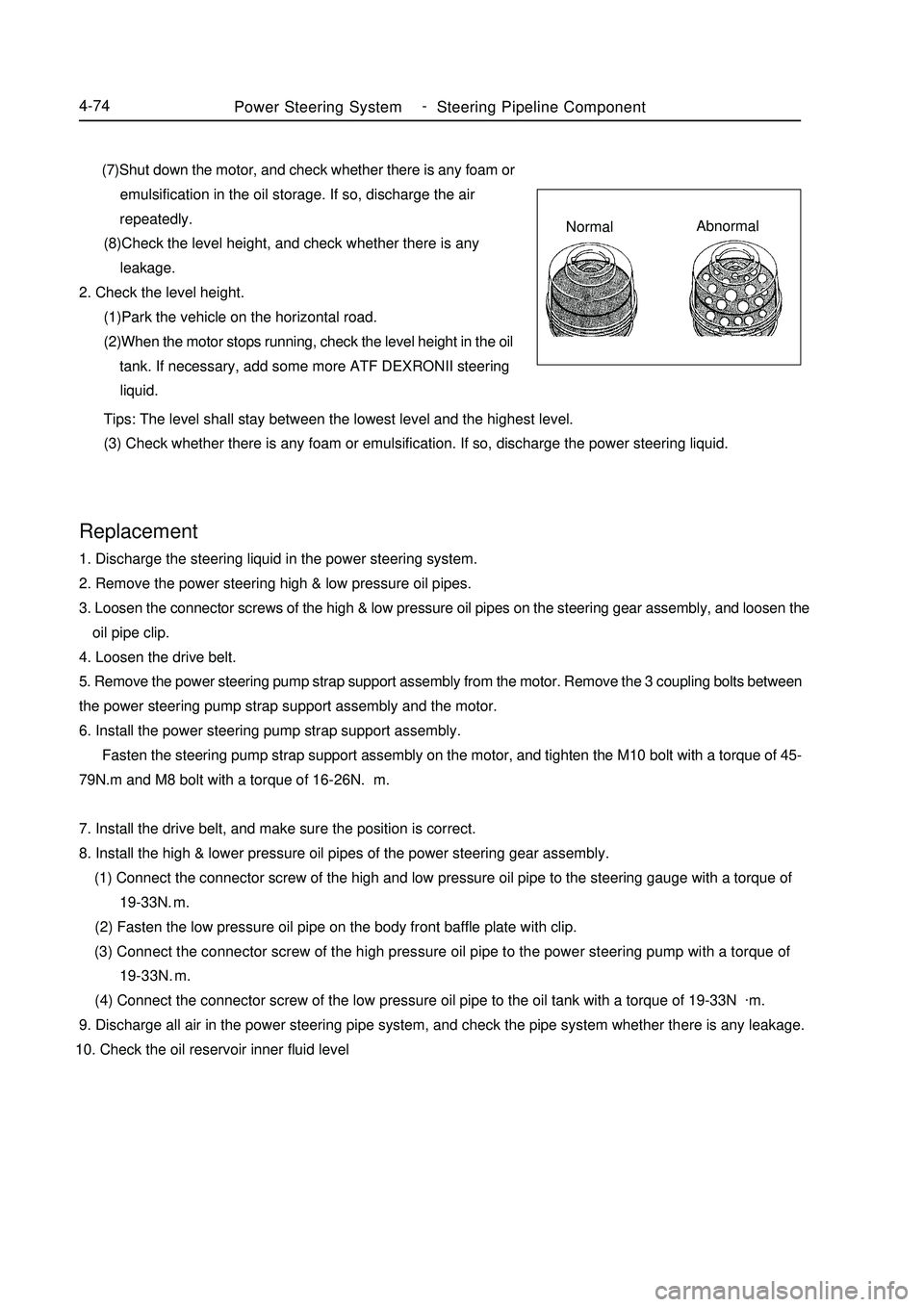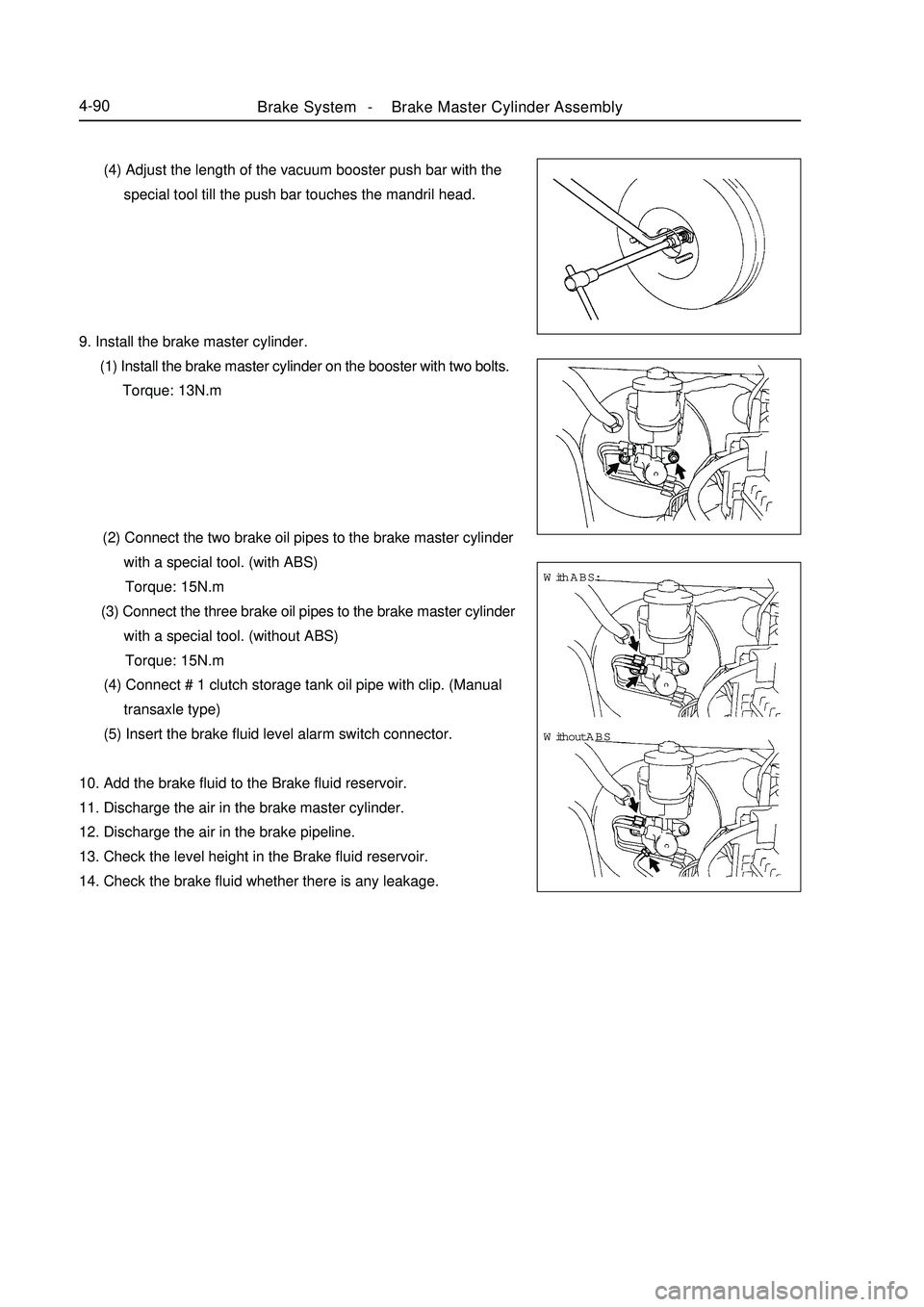oil GEELY MK 2008 Repair Manual
[x] Cancel search | Manufacturer: GEELY, Model Year: 2008, Model line: MK, Model: GEELY MK 2008Pages: 416, PDF Size: 25.19 MB
Page 125 of 416

Front Suspension System-Front Strut Assembly4-4828. Mount the dust seals of left front suspension bracket
29. Mount the left front suspension bracket sub-assembly
30. Mount the front bracket onto the left front shock absorber nuts
(1) Hold the bracket by two bolts and a screwdriver or analogue.
Mount the new centre nut
Torque: 33N.m
Notice: DonÕt cause damage to the stud of suspension bracket.
(2) The special tool for remove
(3) Apply the multipurpose grease onto the suspension bracket
31. Mount the dust cap of left front suspension bracket
32. Mount the front stud assembly
(1) Mount the #2 suspension bracket
(2) Mount the front stud assembly by three nuts
Torque: 39N.m
(3) Mount the shock absorber onto the knuckle
(4) Film the engine oil onto the thread of two nuts
(5) Mount the two bolts and nuts
Torque: 132N.m
33. Mount the brake hose
Torque: 29N.m
34. Mount the front wheel
Torque: 103N.m
35. Mount the outside cover of vehicle neck
(1) Mount the outside cover of vehicle neck by 8 bolts
Torque: 5N.m
(2) Connect hose and harness (screen wiper)
(3) Mount the harness by bolts and two clips
36. Mount the linkage assembly of windshield wiper
37. Mount the ventilation hood of left vehicle neck
38. Mount the ventilation hood of right vehicle neck
39. Mount the engine hood and seals of vehicle neck
40. Mount the left front wiper arm
41. Mount the right front wiper arm
42. Check and adjust the front wheel alignmentMulti-purpose grease
Page 132 of 416

I. Rear suspension structure description This model uses strut independent rear suspension with stabilizer bar.
Rear suspension consists of the parallel front and rear double transverse arms, trailing rod, rear stabilizer bar
and rear strut assembly. The shock absorber and cone coil spring are arranged eccentrically.
See the table below for the major technical parameters of the rear suspensionII. Symptom Table Use the table below to help you find the cause of the problem. The numbers indicate the priority of the likely
cause of the problem. Check each part in order. If necessary, replace these parts.Suspected Area
1. Tires (Worn or improperly inflated)
2. Wheel alignment (Incorrect)
3. Hub bearing (Worn or damaged)
4. Suspension parts (Worn or damaged)
1. Vehicle (Overloaded)
2. Spring (Stiffness small)
3. Shock absorber (Worn)
1. Tire (Worn or improperly inflated)
2. Wheel (not within specification)
3. Shock absorber (Worn)
1. Tire (Worn or improperly inflated)
2. Wheel alignment (Incorrect)
3. Shock absorber (Worn)
4. Wheel (not within specification)
1. Tire (Worn or improperly inflated)
2. Wheel alignment (Incorrect)
3. Shock absorber (Worn)
4. Suspension parts (Worn or damaged)Symptom
Off track
Body descent
Sways
Rear wheel shimmy
Abnormal tire wearRear Suspension System-Rear Suspension System4-55Item
Shock absorber operating cylinder diameter /mm
Shock absorber piston rod diameter/mm
Shock absorber stroke /mm
Camber
Toe in/mm
Remark: Wheel alignment parameter is at free loadParameter
38
12.4
250
-0°56' ± 45'
3 ± 3
Page 134 of 416

Section 3 LH/RH Rear Suspension Coil SpringReplacement1. Remove rear wheel
2. Remove the wire of the wheel speed sensor(with ABS)
(1) Remove the connector of wheel speed sensor.
(2) Remove bolts and wheel speed sensor from rear axle
frame.
Notes:
Remove the right sensor wire by using same process as left.
3. Remove the load-sensing valve bracket (without ABS)
Remove two nuts and load-sensing valve bracket from the axle
bracket
4. Remove the proportioning valve and rear right brake tube
(1) Remove the proportioning valve and rear right brake tube by
the special tool
(2) Remove the clips
Notes: Don't reuse the clips
5. Remove the proportioning valve and rear left brake tube
Notes: use the same operations of the proportioning valve and
rear right brake tube to remove #3 rear brake tube.
6. Remove right parking brake cable assembly
Remove nuts and right parking brake cable assembly
assembly from rear axle frame
7. Remove left parking brake cable assembly
8. Loose the rear axle assembly
Loose two 2 boltsRear Suspension System-LH/RH Rear Suspension Coil Spring4-57
Page 135 of 416

9. Remove the left rear shock absorber assembly
(1) Lift the rear axle at left sustainer by lifting jack
(2) Remove nuts, washers and left rear shock absorber assembly
10. Remove right rear shock absorber assembly
Notes: Remove right rear shock absorber assembly by using same
operations as left.
11. Remove left rear helical spring
Slowly lower lifting jack, remove helical spring and upper pads
and lower pads
12. Mount the left rear helical spring
(1) Mount the upper pad, let gap right on the helical spring.
(2) Mount lower pad, let and load the left helical sprig into the rear
axle.
13. Temporarily tighten the left rear shock absorber assembly
(1) Mount the left rear shock absorber onto rear axle frame when
lift jack.
(2) Temporarily tighten nut and washer.
14. Temporarily tighten the right rear shock absorber assembly.
Notes: Mount the right assembly by using same operations as left.
15. Mount right parking brake cable assembly
Mount right parking brake cable assembly by nuts
Torque: 5.4 N.m
16. Mount left parking brake cable assembly.
Tips: Mount the right assembly by using same operations as left.
17. Mount the proportioning valve and rear right brake tube
(1) Connect the brake hose with brake tube by special tool.
Torque: 1 5 N.m
(2) Mount clipsRear Suspension System-LH/RH Rear Suspension Coil Spring4-58
Page 136 of 416

Rear Suspension System-LH/RH Rear Suspension Coil Spring4-5918. Mount rear right brake tube
Tips:
Mount the right assembly by using same operations as left.
19. Mount sideslip control sensor wire (with ABS)
(1) Tighten sideslip control sensor wire by bolts
Torque: 8.0 N.m
(2) Mount sideslip control sensor wire
Attention: Mount the right wire by using same operations as left.
20. Mount load-sensing valve bracket (without ABS)
Mount load-sensing valve bracket by two buts
21. Sufficiently tighten the rear axle frame assembly
(1) Stabilize the shock absorber assembly
Use the lifting jack and add 90Kg force on rear luggage
carrier if bolts can not be tightened at this point.
(2) Sufficiently tighten bolts
Torque: 82 N.m
22. Sufficiently tighten the left rear shock absorber assembly
Sufficiently tighten nuts
Torque: 49 N.m
23. Sufficiently tighten the right rear shock absorber assembly
Tips: Mount the right rear shock absorber by using same opera-
tions as left.
24. Release the air in the brake hose
25. Mount the rear wheel
Torque: 103 N.m
26. Check rear the wheel alignment
27. Check the wheel speed sensor signal of ABS( with ABS)
Page 151 of 416

Power Steering System-
Steering Pipeline Component4-74 (7)Shut down the motor, and check whether there is any foam or
emulsification in the oil storage. If so, discharge the air
repeatedly.
(8)Check the level height, and check whether there is any
leakage.
2. Check the level height.
(1)Park the vehicle on the horizontal road.
(2)When the motor stops running, check the level height in the oil
tank. If necessary, add some more ATF DEXRONII steering
liquid.Replacement1. Discharge the steering liquid in the power steering system.
2. Remove the power steering high & low pressure oil pipes.
3. Loosen the connector screws of the high & low pressure oil pipes on the steering gear assembly, and loosen the
oil pipe clip.
4. Loosen the drive belt.
5. Remove the power steering pump strap support assembly from the motor. Remove the 3 coupling bolts between
the power steering pump strap support assembly and the motor.
6. Install the power steering pump strap support assembly.
Fasten the steering pump strap support assembly on the motor, and tighten the M10 bolt with a torque of 45-
79N.m and M8 bolt with a torque of 16-26N.m.
7. Install the drive belt, and make sure the position is correct.
8. Install the high & lower pressure oil pipes of the power steering gear assembly.
(1) Connect the connector screw of the high and low pressure oil pipe to the steering gauge with a torque of
19-33N.m.
(2) Fasten the low pressure oil pipe on the body front baffle plate with clip.
(3) Connect the connector screw of the high pressure oil pipe to the power steering pump with a torque of
19-33N.m.
(4) Connect the connector screw of the low pressure oil pipe to the oil tank with a torque of 19-33N.
m.
9. Discharge all air in the power steering pipe system, and check the pipe system whether there is any leakage.
10. Check the oil reservoir inner fluid level Tips: The level shall stay between the lowest level and the highest level.
(3) Check whether there is any foam or emulsification. If so, discharge the power steering liquid.NormalAbnormal
Page 153 of 416

Steering rack end sub-assembly
Steering rack end sub-assembly
Left ball extension shaft Left ball extension shaftComponent ViewPower Steering System-Power Steering Gear4-76Lock nut
Steering rack # 1 dust shield
Clip
Hoop
O-ring Steering hydraulic
oil pipe
O-ring
Hoop
Clip O-ring
Steering rack # 2 dust shield
Non-reusable parts
Power steering oil
Special toolLock nut
Specified torque
Page 156 of 416

Brake System -Brake System4-79Chapter 9 Brake SystemSection 1 Brake SystemI. Precaution 1. It's very important to keep the parts and area clean when repairing the brake system.
2. Care must be taken to replace each part properly as it could affect the performance of the brake system and
result in a driving hazard.
3. Do not let brake fluid remain on a painted surface when repairing any parts. Wash it off immediately.
4. If any work is done on the brake system or air in the brake pipelines is suspected, bleed the system of air.
5. Check the brake system for leakage after repairing the brake system.
6. Use specified brake fluid. Do not mix with other brand of brake fluid.II. Symptom table Use the table below to help you find the cause of the problem. The numbers indicate the priority of the likely
cause of the problem. Check each part in order. If necessary, replace these parts.Symptom
Low brake pedal or recoil
Brake StagnationSuspected Area
1 Brake system (fluid leaks)
2 Brake system (air in)
3 Piston Cup in Sub-pump (worn or damaged)
4 Rear brake shoe clearance (out of adjustment)
5 Master cylinder (faulty)
6 Booster push rod (out of adjustment)
7 Brake shoe or lining (oily)
8 Disc/Drum scratched
1. Brake pedal free stroke is too small
2. Parking brake lever stroke (out of adjustment)
3. Parking brake cable (sticking)
4. Rear brake shoe clearance (out of adjustment)
5. Brake pad or lining (cracked or distorted)
6. Wheel cylinder piston (stuck or frozen)
7. Return spring (faulty)
8. Vacuum booster (faulty)
9. Brake master cylinder (faulty)
Page 157 of 416

Brake System -Brake System4-80Symptom
Brake Deviation
Noise from brakeSuspected Area
1. Wheel cylinder piston (stuck)
2. Brake shoe lining (oily)
3. Disc (scratched)
4. Brake shoes or lining (cracked or distorted)
5. Wheel hub bearing (worn or damaged)
6. Tire pressure (not as specified)
1. Brake shoe lining (damaged)
2. Installation bolt (loose)
3. Disc (scratched)
4. Brake shoe (bad in quality)
5. Brake shoes lining (oily)
6. Sound isolating shim damaged
7. Hold spring of brake shoe (damage)
Page 167 of 416

Brake System -Brake Master Cylinder Assembly4-90 (4) Adjust the length of the vacuum booster push bar with the
special tool till the push bar touches the mandril head.
9. Install the brake master cylinder.
(1) Install the brake master cylinder on the booster with two bolts.
Torque: 13N.m
(2) Connect the two brake oil pipes to the brake master cylinder
with a special tool. (with ABS)
Torque: 15N.m
(3) Connect the three brake oil pipes to the brake master cylinder
with a special tool. (without ABS)
Torque: 15N.m
(4) Connect # 1 clutch storage tank oil pipe with clip. (Manual
transaxle type)
(5) Insert the brake fluid level alarm switch connector.
10. Add the brake fluid to the Brake fluid reservoir.
11. Discharge the air in the brake master cylinder.
12. Discharge the air in the brake pipeline.
13. Check the level height in the Brake fluid reservoir.
14. Check the brake fluid whether there is any leakage.With ABS:
Without ABS